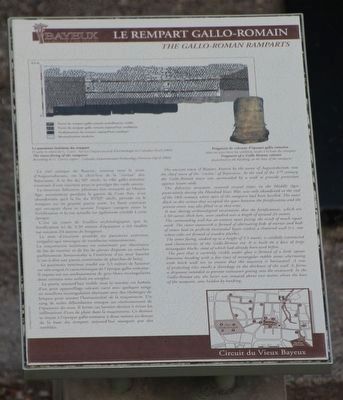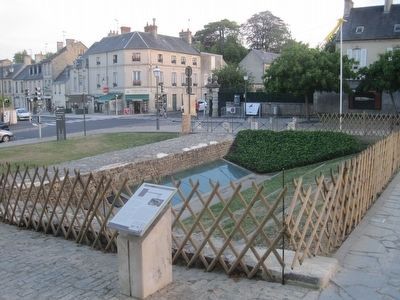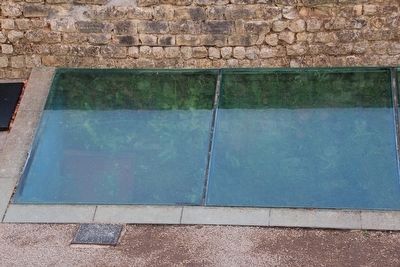Bayeux in Calvados, Normandy, France — Western Europe
Le Rempart Gallo-Roman
A 10th Century Building
— Bayeux, la Qualité a ses Racines —
La cite antique de Bayeux, connue sous le nom d’Augustodurum, est le chef-lieu de la “civitas” des Bajocasses. A la fin du IIIe siècle, la ville gallo-romaine s’entoure d’une enceinte pour se protéger des raids saxons.
La structure défensive, plusieurs fois restaurée au Moyen Age, notamment pendant la guerre de Cent Ans, n’est abandonnée qu’à la fin du XVIIIe siècle, période où le rempart est en grande partie arasé. Le fossé extérieur qui occupait dans ce secteur l’espace compris entre la fortification et la rue actuelle est également comblé à cette époque.
C’est au cours de fouilles archéologiques que la fortification ici de 3.50 mètres d’épaisseur a été étudiée sur environ 24 mètres de longueur.
Le mur d’enceinte possède un parement extérieur irrégulier qui témoigne de nombreux remaniements. La maçonnerie intérieure est constituée par alternance de lits de mortier et de lits de pierres disposés en couches parfaitement horizontales a l’intérieur d’un mur banché (c’est-à-dire aux parois constituées de planches de bois).
Le parement intérieur étudie sur 3.5 mètres de hauteur est très soigne et caractéristique de l’époque gallo-romaine. Il repose sut un soubassement de gros blocs rectangulaires dont certains sont utilisés en remploi.
La partie aujourd’hui visible sous la verrière est formée d’un petit appareillage calcaire carré avec quelques rangs en moellons rectangulaires alternant avec des chaînages de briques pour assurer l’horizontalité de la maçonnerie. Un rang de tuiles débordantes marque un rétrécissement de l’épaisseur du mur. Il forme un larmier destiné à éviter les infiltrations d’eau de pluie dans la maçonnerie. Ce dernier se situait à l’époque gallo-romaine à deux mètres au-dessus de la base du rempart aujourd’hui masquée par des remblais.
The ancient town of Bayeux, known by the name of Augustodurum, was the chief town of the "civitas" of Bajocasses. At the end of the 3rd century, the Gallo-Roman town was surrounded by a wall to provide protection against Saxon raids.
The defensive structure, restored several times in the Middle Ages, particularly during the Hundred Years War, was only abandoned at the end of the 18th century, when most of the ramparts had been leveled. The outer ditch in this section that occupied the space between the fortifications and the present street, was also filled in at that time.
It was during archaeological excavations that the fortifications,
which are 3.50 metres thick here, were studied over a length of around 24 metres.
The surrounding wall has an uneven outer facing , the result of much repair work. The inner stonework is formed of alternating beds of mortar and beds of stones laid in perfectly horizontal layers within a shuttered wall (i.e., one whose sides are formed of wooden planks).
The inner facing, studied up to a height of 3.5 metres, is carefully constructed and characteristic of the Gallo-Roman era. It is built on a base of large rectangular blocks, some of which had already been used before.
The part that is currently visible under glass is formed of a little square limestone bonding with a few rows of rectangular rubble stones alternating with brick wall ties to ensure that the masonry is horizontal. A row of projecting tiles marks a shrinkage in the thickness of the wall. It forms a dripstone intended to prevent rainwater getting into the stonework. In the Gallo-roman era, the latter was situated about two metres above the base of the ramparts, now hidden by banking.
Erected by La ville de Bayeux.
Topics and series. This historical marker is listed in this topic list: Settlements & Settlers. In addition, it is included in the France - Bayeux - Circuit du Vieux Bayeux series list.
Location.
49° 16.505′ N, 0° 42.167′ W. Marker is in Bayeux, Normandie (Normandy), in Calvados. Marker can be reached from the intersection of Rue Larcher and Rue L L le Forestier. Touch for map. Marker is in this post office area: Bayeux, Normandie 14400, France. Touch for directions.
Other nearby markers. At least 8 other markers are within walking distance of this marker. Un édifice du Xe siècle (here, next to this marker); Les Abords du Chevet de la Cathédrale (a few steps from this marker); 50th Northumbrian Division Memorial (within shouting distance of this marker); Le Doyen du Chapitre (within shouting distance of this marker); Le palais Episcopal (within shouting distance of this marker); L'Esplanade Flachat (about 120 meters away, measured in a direct line); L'Aure (about 150 meters away); Autour des Augustines (about 150 meters away). Touch for a list and map of all markers in Bayeux.
More about this marker. The caption on the marker's top drawing reads:
Le parement intérieur du rempart
D’après le relevé de G. Carré – Service Départemental d’Archéologie du Calvados (Avril 2004)
The inner facing of the ramparts.
According to T. Carré’s report – Calvados Departmental Archaeology Division (April 2004)
The caption on the marker's top photograph reads:
Fragment de colonne d’époque gallo-romaine mise au jour dans les remblais situés à la base du rempart.
Fragment of a Gallo-Roman column uncovered in the banking, at the base of the ramparts.
Credits. This page was last revised on September 10, 2018. It was originally submitted on September 25, 2015, by Kevin W. of Stafford, Virginia. This page has been viewed 317 times since then and 5 times this year. Photos: 1, 2, 3. submitted on September 25, 2015, by Kevin W. of Stafford, Virginia. • Andrew Ruppenstein was the editor who published this page.


